
Guide to Creating a Balanced Investment Portfolio
The Complete Guide to Property Investment for Beginners begins with the understanding that a balanced portfolio is a cornerstone of financial success. Crafting an investment strategy that blends risk and reward effectively can protect your assets while offering growth potential. Whether you’re a seasoned investor or a beginner exploring options, diversifying your investments is vital in navigating volatile markets. This article will explore actionable strategies to create a balanced investment portfolio tailored to your financial goals.
What Is a Balanced Investment Portfolio?
A balanced investment portfolio is a mix of asset classes tailored to suit your financial objectives and risk tolerance. Typically, it combines equities (stocks), fixed income (bonds), cash equivalents, and alternative investments like real estate or commodities.
Why Balance Matters
Balancing ensures that when one asset underperforms, another might compensate by performing well. For example, bonds often remain stable or grow during economic downturns, while equities may falter. By balancing your portfolio, you hedge against significant losses.
Step 1: Assess Your Financial Goals
Short-Term vs. Long-Term Goals
Defining your investment objectives is crucial. Are you saving for retirement, building an emergency fund, or planning a large purchase? Short-term goals favour lower-risk investments like savings accounts or short-term bonds, whereas long-term goals often incorporate equities with higher growth potential.
Real-World Example
Consider a 30-year-old professional saving for retirement. Their portfolio might lean toward stocks (70%) and bonds (30%) to take advantage of long-term growth while managing some risk.
Step 2: Understand Risk Tolerance
Risk tolerance varies among individuals. Younger investors often have a higher tolerance because they have time to recover from losses. Older investors nearing retirement may prioritize capital preservation.
Actionable Tip
Take a risk tolerance quiz online or consult with a financial advisor to determine your comfort level with risk.
Step 3: Diversify Your Investments
Equities: Growth and Returns
Stocks typically form the backbone of any portfolio due to their growth potential. However, it ensures sector and geographic diversification. Avoid putting all your money into tech stocks or only U.S.-based companies.
Fixed Income: Stability
Bonds offer predictable returns and reduce volatility. Opt for a mix of government and corporate bonds for stability.
Alternative Investments
Consider real estate, REITs, or commodities like gold to diversify further. Real estate, for example, provides passive income and can act as a hedge against inflation.
Step 4: Choose the Right Asset Allocation
The Rule of 100
Subtract your age from 100 to determine the percentage of your portfolio in equities. For example, a 40-year-old might hold 60% in stocks and 40% in bonds and other assets.
Dynamic Allocation
Adjust allocations periodically to reflect changes in age, risk tolerance, or market conditions. For example, shifting towards safer bonds may make sense during a recession.
Step 5: Monitor and Rebalance Regularly
Over time, some assets will outperform others, leading to an unbalanced portfolio. Rebalancing involves selling overperforming assets and reinvesting in underperforming ones to maintain your desired allocation.
How Often Should You Rebalance?
Experts suggest rebalancing once a year or whenever your allocation strays significantly from the target.
Common Mistakes to Avoid
Over-Diversification
While diversification is essential, spreading yourself too thin can dilute returns. Stick to a manageable number of investments you can track.
Ignoring Fees
Pay attention to expense ratios in mutual funds or ETFs, as high fees can erode your returns over time.
Emotional Decision-Making
Avoid panic selling during market downturns. Remember, investing is a long-term game.
Using Technology for Portfolio Management
Investment Apps
Platforms like Robinhood, Vanguard, and Wealthfront make tracking and managing your portfolio easy. Many apps offer robo-advisors that automatically adjust your allocation based on your goals.
Portfolio Tracking Tools
Apps like Personal Capital allow you to monitor performance, calculate net worth, and even project retirement outcomes.
The Role of Professional Advice
While DIY investing works for many, seeking professional advice can provide tailored strategies. Financial advisors can help you navigate tax implications, optimize asset allocation, and avoid costly mistakes.
Conclusion
Creating a balanced investment portfolio is a dynamic process that requires clear goals, risk assessment, and periodic adjustments. Diversification across asset classes is your shield against market volatility, while regular rebalancing ensures alignment with your objectives. Start small, stay consistent, and remember that patience is key to successful investing. Are you ready to build a portfolio that balances growth and security? Take the first step today and secure your financial future.
Read also: The Complete Guide to Financial Independence for Beginners




